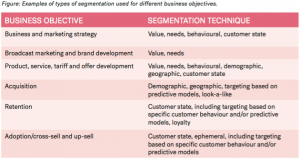Eight things to think about to master modern segmentation best practice
Share
Experian’s Karena West shares lessons on how to identify the right approach to segmentation for your objectives, from her extensive experience working on segmentation projects.
_
This article originally appeared in The Identity Issue, our October/November issue of Marketing mag.
_
I am a big believer in learning from my experiences. I have been through many major segmentation builds in my career and I have learned many lessons. Here are some of my reflections to get you started.
1. Segment sizing
 When you are evaluating your segmentation solutions consider the individual sizes of the segments. Segment sizes that are too big and also too small can be a problem later on when you are incorporating them into your marketing activities. I have found that if the segments are too small it is hard to action and justify campaign programs, and if they are too big the group is too broad and you can’t action anything without segmenting the segment.
When you are evaluating your segmentation solutions consider the individual sizes of the segments. Segment sizes that are too big and also too small can be a problem later on when you are incorporating them into your marketing activities. I have found that if the segments are too small it is hard to action and justify campaign programs, and if they are too big the group is too broad and you can’t action anything without segmenting the segment.
This problem can also manifest when you switch between the full market view and your current customer base. So review your segment sizes with both a full market lens as well as your customer base, making sure that they both adhere to your minimum and maximum segment sizing. As a rule of thumb I like to have segments where the smallest segment is no smaller than 10% of the population and the largest is no larger than 30% of the population. These percentages will change depending on your business requirements, but are a good starting point.
2. Differentiating the segments
Segmentation is the division of the consumer marketplace into groups or segments. How the segments are divided is determined by the dimensions and variables associated to the purpose of the segmentation. For example, a needs- or values-based segmentation will have segments that differentiate primarily on core needs.
Secondary dimensions can also be incorporated to help with the connection to the database or to align with business contact constraints. For instance, for the needs-based segmentation example you may also want to have the segments differentiate on base demographics and channel preference.
3. Static versus dynamic
A static segmentation is one where the consumer is allocated a segment and then they stayed locked into the segment for an extended period of time. A dynamic segmentation, on the other hand, is where the consumer has the ability to move between segments depending on the behaviour they exhibit. There is no right or wrong answer to which one is better and it will depend on the type of segmentation you are building, as well as the impact to customer experience.
An example of a dynamic segmentation is a value/ margin base segmentation. The customer value to the company will change over time and therefore you will want to reflect this in their value segment. A needs- or value-based segmentation is an example of a static segmentation. The theory behind this type of segmentation is that a person’s core values don’t change; therefore the segments stay fixed.
Static segmentation can be used as a great measurement of success. Once a customer is assessed and assigned a segment they are locked in for a period of time. Then, as the ebb and flow of acquisition and churn occurs, the business can monitor the success of their segment strategies. But the act of segmenting is to understand and alter behaviour. Therefore, you need to cope and account for this change.
Be looking for the customer behavioural change and, when you see it has moved from a sometimes to an always, then you need to have the process to action it. Front of house staff will give you good feedback and, if they are given the correct incentives, they can also be a data capture point for non-database attributes. The digital landscape tends to be a more dynamic environment and you tend to see the decay in the segment accuracy faster than some of your more traditional marketing channels.
4. Segment names and descriptions
There are a lot of interesting discussions on whether the segment groups should have names, images and descriptions. Some believe more generic segment names that are generic things like colours are more effective, as you are not given preconceived ideas of the segments.
My perspective is that I like naming and adding visualisation as I believe it helps people connect with the segments. But (yes another but), be careful. Is there a chance that your customers will see the segment name associated with their account (like on a screen of front of house staff)? If the answer is yes or even maybe, then choose your names wisely as no one wants to know they are in the ‘old and poor’ segment and it probably wouldn’t help your NPS (net promoter score) either. Some companies will require the legal team to sign them off, so you may want to check this at your company.
Investing in the task of naming, colour schemes and the like is recommended where the expectation is that the segmentation will be used and shared across a wide audience. If multiple departments, varied statistical knowledge levels and various applications are the goal of the segmentation, then the easier to understand and more easily consumed the segmentation, the better.
5. Market research versus database
Depending on the type of segmentation you may or may not need consumer data outside your internal database. Base demographic data about the consumer market can be purchased, but if you need to ask specific questions then you will most likely need market research.
Market research can be a real asset to a segmentation, as it will give you information and reasons you can’t get from your database. This is also the most common place that companies come unstuck with segmentation projects because, depending on how the data is collected and collated, there will be a direct impact on how the segmentation can be used by the business. Basically, unless you are doing a theoretical segmentation or you don’t have a customer database, you will need a way of connecting the segmentation to the existing customers and the potential customers.
In order to create the links between the market research survey and existing and prospective customer databases, you need to do one of the following:
- Create references or links to the respondents by asking for their address (something you normally have to give an incentive for), which can then be used to connect to external or internal information. You need to have a good relationship with your market research agency to make this happen and remember any that you can’t match can’t be used in the segmentation build.
- The other alternative to this is to ask common questions in the survey that you can also find in your internal or external data. This can be frustrating as you not only use up valuable questions on your survey, but you also will have a form or fuzzy match to build your segments, rather than a direct match.
- The worst case (and the most common, unfortunately) is that the survey is performed and there is no connections created to the database. This means that in order to connect the segments you are left with two options: go back to the survey respondents and do one of the two options above, and infer the segments manually, which becomes very unsophisticated and undoes all your beautiful segmentation work.
6. Segment prediction accuracy
For segmentation models where you need to update or refresh the segment allocations against your existing customers and/or prospective consumers, then you need to consider how often this needs to occur and how you are going to manage the segment modelling processes.
If your segmentation includes market research it could become costly and unwieldy to refresh regularly. One method to manage this is to build a model or models to predict the segments using only your internal data and potentially any external data you have purchased. This method allows you to have the richness of the detailed research while balancing the ongoing business requirements.
If you are planning on following this approach, then my advice is to build the raw segmentation solution and the segmentation prediction models at the same time. In effect one of the solution sign-off criteria will become the prediction accuracy. The art becomes finding the balance between a segment solution that is meaningful and also that you can accurately attribute. As a rule of thumb, I have seen prediction criteria of 70% overall across all segments and 70% for the individual segments. These percentages will be dictated by your business requirements for accuracy.
7. What will you do differently?
A good segmentation will align with your business strategy, but also consider how you are going to use it in the current marketing and campaign management landscape and any planned changes you are considering. Is your business ready and capable to do things differently? Can the channels cope with the different needs your segmentation may uncover?
The best segmentation framework in the world will still not deliver a return if a business can’t conceive and execute worthwhile strategies. After all, what’s the point in having segments if the customer experience is hardly different across each?
Before you start, have a think about what you are going to physically do differently for each segment. If, for example, you want to communicate through different channels or offer different products or services, then you need to make sure that your segment solution gives you the differentiation you need.
A good segmentation requires different propositions for different customer groups. This is a worthwhile investment post segmentation (CVP development) that is often overlooked. Up until this point how your propositions resonate with the different segments are only an internal view.
8. The single customer view
Understanding who your customers are is a key requirement to any segmentation. This may seem like a silly point, but often companies have large amounts of detail about accounts but little about the person using them and their ability to connect accounts together to a single customer is often poor. The old days of IT-led CRM projects are a thing of the past and single customer view projects can be completed in months rather than years and definitely worth the investment.
The single customer view can be extended beyond just your existing customers to your prospect customer base. This view can house your segmentation tags and other predictive models, as well as consumer attributes, and will allow the business to view the customers in their totality and not just in their individual components.
* * * * *
Want to learn more? Marketing Pro Members can download the new ‘Mastering Segmentation’ guide with step-by-step template. Upgrade to Pro for full access to this tool and many more marketing resources.
* * * * *
Image copyright: chris_elwell / 123RF Stock Photo
















